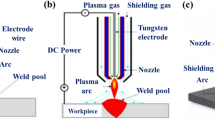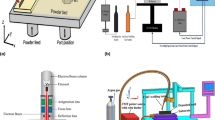Abstract
Application of strip cladding using electroslag welding process to cover large surface areas of vessels for oil and gas industries has been a common weld cladding method in last few decades. There has been continuous development by welding consumable suppliers to improve this method further through introduction of high-speed ESW flux and specially designed over-alloyed welding strips to achieve required weld metal chemistry in single layer for some of the alloys. However, the conventional method had limitations in achieving desired chemistry with single layer for certain alloys—Ni-625 alloy with max. 5% Fe is one among them. A new variant of electroslag cladding technique (Hybrid Electro Slag Cladding or H-ESC) has successfully been developed and introduced in the market, wherein a 3rd dimension has been added to the conventional ESW strip cladding method of using strip and flux in the form of addition of multiple hot metal cored wires into the molten electroslag weld pool. Addition of multiple hot MCW wires with a particular proportion into the molten weld pool by a uniquely designed digital weld control system helps in controlling the dilution level, thereby achieving clean undiluted cladding chemistry coupled with at least 50% higher welding speed and nearly double the weld deposition rate as compared to conventional ESW cladding technique. In this new high-speed single-layer cladding technique using neutral flux, it is possible to achieve Fe content < 5% for Ni-625 cladding and > 40% Ni for Ni-825 cladding in single layer. Similarly, this new technique offers unique solution in case of high-speed single-layer austenitic stainless steel cladding, wherein only one standard stainless steel strip type is used along with neutral flux and desired AWS clean weld metal chemistry is easily achieved for SS 308L, SS 316L, SS 347, and SS 317L by using suitably designed MCW wires. Such solution would immensely help fabricators to minimize their working capital and faster delivery of weld consumables in addition to reaching desired 3.0 mm undiluted weld chemistry in high-speed single-layer cladding of 3.5-mm thick.












Similar content being viewed by others
References
Chattopadhyay P Mukherjee MK, Trivedi YS (1996) Presented in International Welding Conference (IWC’96), Mumbai – India. Conference Proceedings, pp A-086-1 to A-086-7
Dilthey U et al (2006) Modification of the electroslag process opens up possibilities with regard to weld surfacing. Weld Cutt DVS 5(4):215–220
Mark S (2013) Golding – US Patent: US2013 / 0004674A1
Published commercial data from different consumable manufacturers and Lincoln electric internal data. www.lincolnelectric.com/nl-nl/support/process-and-theory/Documents/STRIP_CLADDING_ENG.pdf
Chattopadhyay P, Nateghi A (2017) Hybrid technique for electroslag strip cladding of critical process equipment. Hydrocarbon Process J 41–46
Chattopadhyay P, Barone C, Quintiliani D (2017) Presented paper in Italian Welding Conference GNS-9, Genoa- Italy. Paper referred as ‘Barone’ in CD-ROM
Amin N, Pollmann R, Bolte F, Thume C, Golding M, Zhang Z, Chattopadhyay P. U.S. Patent Application 15/737,689 on “Hybrid electro slag cladding”; filed June 28, 2018
Acknowledgement
The authors would like to offer special thanks to the management and technical personnel of their industrial partner Walter Tosto SpA, Italy, for excellent support and cooperation during development and industrialization of H-ESC technique.
Author information
Authors and Affiliations
Corresponding author
Additional information
Recommended for publication by Commission II - Arc Welding and Filler Metals
Rights and permissions
About this article
Cite this article
Chattopadhyay, P., van der Mee, V. & Zhang, Z. Hybrid electroslag cladding (H-ESC): an innovation in high speed electroslag strip cladding. Weld World 63, 663–672 (2019). https://doi.org/10.1007/s40194-018-00692-y
Received:
Accepted:
Published:
Issue Date:
DOI: https://doi.org/10.1007/s40194-018-00692-y




